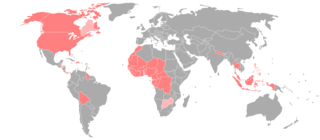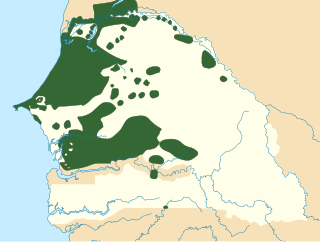 W
WSenegal is a multilingual country: Ethnologue lists 36 languages, Wolof being the most widely spoken language.
 W
WArabic is a Semitic language that first emerged in the 1st to 4th centuries CE. It is now the lingua franca of the Arab world. It is named after the Arabs, a term initially used to describe peoples living in the Arabian Peninsula bounded by eastern Egypt in the west, Mesopotamia in the east, and the Anti-Lebanon mountains and Northern Syria in the north, as perceived by ancient Greek geographers. The ISO assigns language codes to 32 varieties of Arabic, including its standard form, Modern Standard Arabic, also referred to as Literary Arabic, which is modernized Classical Arabic. This distinction exists primarily among Western linguists; Arabic speakers themselves generally do not distinguish between Modern Standard Arabic and Classical Arabic, but rather refer to both as al-ʿarabiyyatu l-fuṣḥā or simply al-fuṣḥā (اَلْفُصْحَىٰ). Modern Standard Arabic is an official language of 26 states and 1 disputed territory, the third most after English and French.
 W
WDyula is a language of the Mande language family spoken in Burkina Faso, Ivory Coast and Mali. It is one of the Manding languages and is most closely related to Bambara, being mutually intelligible with Bambara as well as Malinke. It is a trade language in West Africa and is spoken by millions of people, either as a first or second language. Like the other Mande languages, it uses tones. It may be written in the Latin, Arabic or N'Ko scripts.
 W
WFrench is a Romance language of the Indo-European family. It descended from the Vulgar Latin of the Roman Empire, as did all Romance languages. French evolved from Gallo-Romance, the Latin spoken in Gaul, and more specifically in Northern Gaul. Its closest relatives are the other langues d'oïl—languages historically spoken in northern France and in southern Belgium, which French (Francien) largely supplanted. French was also influenced by native Celtic languages of Northern Roman Gaul like Gallia Belgica and by the (Germanic) Frankish language of the post-Roman Frankish invaders. Today, owing to France's past overseas expansion, there are numerous French-based creole languages, most notably Haitian Creole. A French-speaking person or nation may be referred to as Francophone in both English and French.
 W
WFula, also known as Fulani or Fulah, is a Senegambian language spoken by more than 65 million people as a set of various dialects in a continuum that stretches across some 20 countries in West and Central Africa. Along with other related languages such as Serer and Wolof, it belongs to the Senegambian branch within the Niger–Congo family, which does not have tones, unlike most other Niger–Congo languages. More broadly, it belongs to the Atlantic geographic grouping within Niger–Congo. It is spoken as a first language by the Fula people from the Senegambia region and Guinea to Cameroon, Nigeria, and Sudan and by related groups such as the Toucouleur people in the Senegal River Valley. It is also spoken as a second language by various peoples in the region, such as the Kirdi of northern Cameroon and northeastern Nigeria.
 W
WPulaar is a Fula language spoken primarily as a first language by the Fula and Toucouleur peoples in the Senegal River valley area traditionally known as Futa Tooro and further south and east. Pulaar speakers, known as Haalpulaar'en live in Senegal, Mauritania, the Gambia, and western Mali. The two main speakers of Pulaar are the Toucouleur people and the Fulɓe. Pulaar is the second most spoken local language in Senegal, being a first language for around 22% of the population. This correlates with 23.7% of the country in which Pulaar is the population’s ethnicity. Pulaar is one of the national languages of Senegal alongside 13 others. It was admitted as an official language of Senegal by Presidential decree in 1971. There are around 28 known dialects of Pulaar, most of which are mutually intelligible with each other. The Pulaar dialects, as well as other West African languages, are usually referenced under the umbrella term ‘Fula’. Pulaar as a language, however, is not usually referenced as ‘Fula’.
 W
WThe Mandinka language or Mandingo, is a Mande language spoken by the Mandinka people of Guinea, northern Guinea-Bissau, the Casamance region of Senegal, and in The Gambia where it is one of the principal languages.
 W
WAmerican Sign Language (ASL) developed in the United States and Canada, but has spread around the world. Local varieties have developed in many countries, but there is little research on which should be considered dialects of ASL and which have diverged to the point of being distinct languages.
 W
WWolof is a language of Senegal, the Gambia and Mauritania, and the native language of the Wolof people. Like the neighbouring languages Serer and Fula, it belongs to the Senegambian branch of the Niger–Congo language family. Unlike most other languages of the Niger-Congo family, Wolof is not a tonal language.